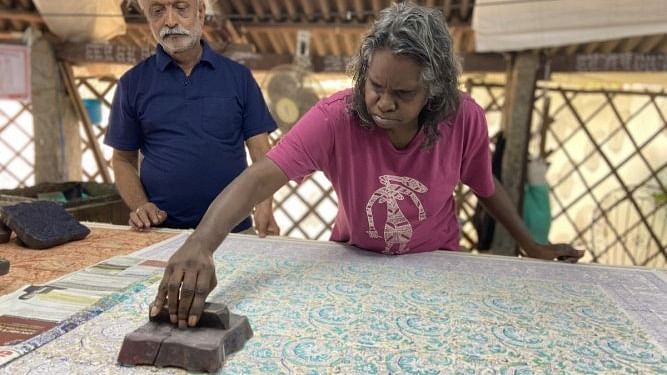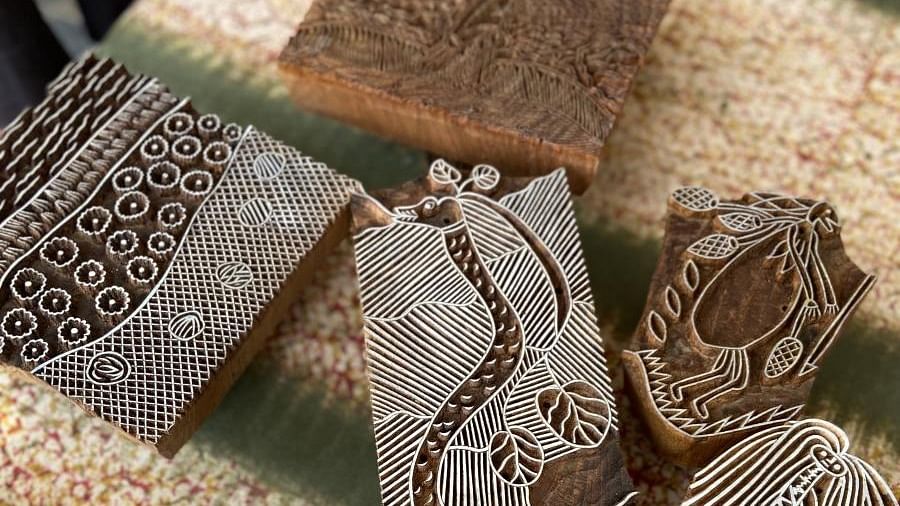

Aboriginal artists from Maningrida, Australia, visited one of Bengaluru’s oldest textile studios, Tharangini Studio, as part of a cultural exchange programme, last Saturday.
Together, they created textiles with organic dyes and handcrafted woodblocks. These collaborative works will be showcased at an exhibition titled ‘Jarracharra’, in the first half of 2023.
Padmini Govind, proprietor of the studio located in Sadashivanagar, explained that their goal is to “keep traditional woodblock printing relevant among the current generation” via collaborations, workshops and other projects.
Artists Deborah Wurrkidj and Janet Marawarr, from Australia’s Babbarra Women’s Centre, who were present at the event, worked with the designs that were carved on woodblocks. “Aboriginal designs come from ancestral stories, which were passed on either orally or in the form of songs and dances. Designs like the mermaid spirit ‘yawkyawk’ and the rainbow serpent ‘ngalyod’, are interpreted differently among various Aboriginal language groups,” informed Jessica Stalenberg, manager of Babbarra Women’s Centre.
The centre uses lino printing, which utilises linoleum sheets to press dyed patterns on fabric. These sheets decompose over time, thus the studio’s artists helped the Aboriginal artists preserve their designs on teak woodblocks. “We have various designs ranging from border patterns that loop on each end for repetition to organic blocks representing flowers and animals in a traditional art style,” Padmini explained.
About differences in design, Jessica said, “In Maningrida, only the person who makes the designs and their family can print it”. In contrast, many motifs used in Indian textiles, such as the paisleys and floral patterns, are a “shared design”, she observes.
The process
As a part of Aboriginal culture, anyone who uses a design must take permission from the ‘dungjay’ (land manager), explains Jessica. The studio’s artists took consent from the other artists, before carving their designs into woodblocks. “Carving these was a challenge — the woodblocks must allow end-to-end repetition of the original designs by the Aboriginal artists,” informs Padmini. The studio’s artists taught the Aboriginal artists to print using woodblocks with custom-made dye.
Paving the path
To produce dye for woodblock printing, the studio uses organic ingredients like turmeric for yellow and Indian madder for red. The artists stone ground them as metal grinders react with the dye and change the colour.
Apart from traditional woodblock printing, the studio also does discharge printing where the pattern is formed by removing the dye from a dark fabric. “Nowadays industries use chemicals to discharge the dye, but we retain the traditional organic means by using a natural resin such as gum arabic,” says Padmini. The gum is mixed with zinc to form a gooey paste, which acts as the binder for the dye. The textiles are then steamed for at least six hours before washing, elaborates Padmini.
Even the process of carving the wood is intricate, says Padmini. “As they apply outlines and colours in successive layers, the wood carver has to ensure that the alignment of each block is precise,” she added.
The exhibition plans to tour Mumbai, Chennai and Bengaluru.